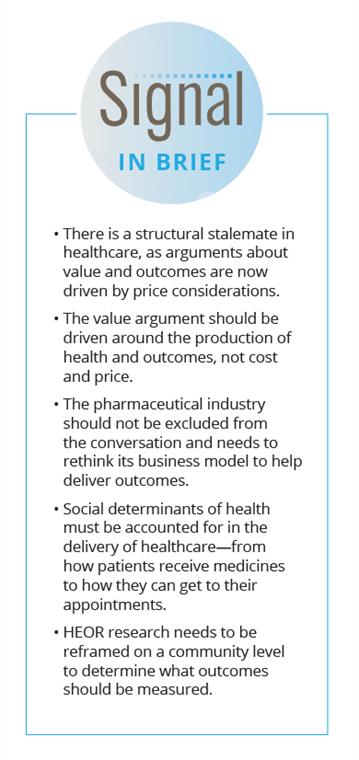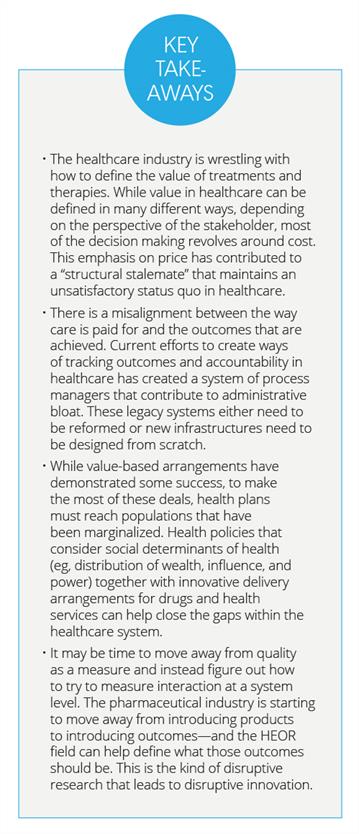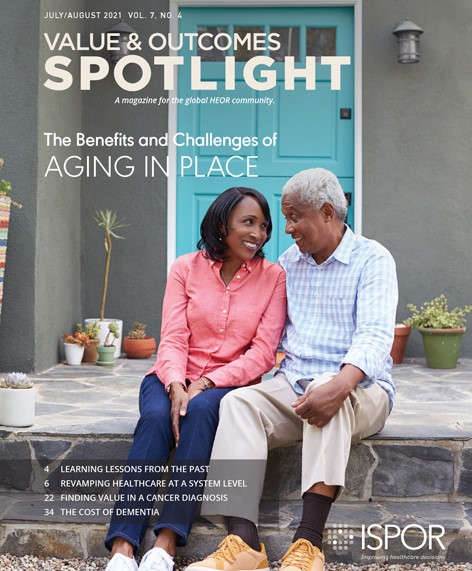From Measuring Costs to Measuring Outcomes: Revamping Healthcare at a System Level
Healthcare stakeholders are wrestling with how to define the value of treatments and therapies. The problem is that while value in healthcare can be defined in many different ways, depending on the perspective of the stakeholder, most of the decision making revolves around cost. This emphasis on price has made the pharmaceutical industry a favorite target of critics and reformers and has contributed to a “structural stalemate” that maintains an unsatisfactory status quo in healthcare.
John Singer, Executive Director of Blue Spoon Consulting and moderator of ISPOR’s latest Signal episode that explored innovative approaches to how the industry views price and value in healthcare, summarized the problem this way, “With this structural stalemate, you’ve got the PBMs (pharmacy benefit managers) that are that are blaming pharma, and pharma is blaming the PBMs. And you’ve got everybody mad at the insurance companies. So, there’s this massive finger pointing, which is basically the structural stalemate.”
Singer maintains that addressing the unmet need in healthcare requires an entirely different narrative—one that captures pharmaceutical company input in a different way and is centered around the production of health and outcomes, not cost and price.
And while determining clinical outcomes needs to be part of the approach, it cannot be not the only driver. Pharmaceutical manufacturers that can figure out how to define the value a new product brings to the community—in addition to the clinical outcomes—can create shifts in competition and true innovation at the system level.

Getting Into System-Level Strategy
In ISPOR’s second Signal series event, “From Price Determining Value to Value Determining Price: It’s About Strategy at a System Level,” panelists debated about how to bring system-level thinking to healthcare and how the pharmaceutical industry, payers, and health economics and outcomes research experts can work together in a new system for commercial strategy. In addition to Singer, the panel was comprised of Alexander Billioux, MD, DPhil, Vice President, Social Determinants of Health, UnitedHealthcare Government Programs, Minnetonka, MN, and Michele Markus, Head of Global Health Accounts, Omnicom, New York, NY.
When talking about the composition of value and outcomes, the panelists were asked to consider whether there is a difference between price and cost, and how they are related to the production of health. In the United States, this preoccupation with healthcare cost dates back at least 50 years to the Johnson administration, and today the conversation still has not changed. The discussion focused on how we shift the narrative to the production of health being the basis of competition strategy.
According to Billioux, the emphasis on cost is a symptom of continued dysfunction, and while spending continues to go up, outcomes are moving in the opposite direction. As a result, there is a misalignment between the way care is paid for and the outcomes that are achieved. “At the end of the day, health outcomes aren’t something that are readily defined in a consistent way, and it’s not something seen immediately,” Markus said. In other words, the issue is to create a system for personalized care and determine accountability in the healthcare system. While not advocating for a national healthcare system in the United States, Markus believes there must be accountability within each of the players currently involved.
Meanwhile, the current efforts to create ways of tracking outcomes and accountability in healthcare has created a system of process managers that contribute to administrative bloat. That raises the question of whether these legacy systems should be reformed, or if the “Gordian knot” should be cut and new infrastructures designed from scratch.
“There has to be some acceptance from governments, from payers, and from everyone in the court of public opinion that pharma is able to engage in the conversation.”—Michele Markus
“We need to be modern in our metrics and have realistic expectations of what each of the players in the healthcare system can actually contribute,” Markus said. This means determining what is reasonable for each agency to contribute and what role everyone plays—from patients, to the pharmaceutical industry, to PBMs. “Right now, there’s a lot of finger pointing across the board but not a lot of end-to-end ownership, because no individual entity can own the end-to-end chain [in healthcare].”
Is there a practical way for pharma to collaborate with payers to address outcomes? Billioux noted that in states with innovative pricing arrangements, such as Oklahoma, Louisiana, and Washington, there was not “line editing collaboration” with pharmaceutical companies, but “clearly there were discussions before those policies went into place to test the waters on what value-based arrangements look like.” When Billioux was at the Louisiana Department of Health, he helped pioneer the state’s “Netflix” arrangement with Gilead for hepatitis C drugs. In other words, similar to the way Netflix viewers pay a flat rate per month to stream as many shows as they want, Louisiana contracted with Gilead to pay a flat fee per year for all the drugs needed to treat prisoners and low-income residents with hepatitis C in an effort to eradicate the disease in the state. Now these value-based arrangements are being talked about more broadly. “They’re still volume-based by default, but I think it leaves open the door for more outcomes-based risk arrangements,” Billioux said. In fact, United Healthcare is moving more of its pharmacy spend into value-based arrangements.

The panelists agreed that this shift into value-based spend means determining where pharmaceutical companies should be involved in healthcare delivery. “There has to be some acceptance from governments, from payers, and from everyone in the court of public opinion that pharma is able to engage in the conversation,” Markus said. The other part is looking at how modern healthcare delivery is transforming, as it’s not just payers, healthcare systems, and the pharmaceutical industry anymore. “We’re seeing the cohesion of a lot of former business models now being rethought, combined, and merging in different ways, whereby the traditional division lines that have occurred are no longer applicable,” Markus said.
Could the different industry entities—such as America’s Health Insurance Plans, Pharmaceutical Research and Manufacturers of America, and Pharmaceutical Care Management Association—come together to provide an industry-level shift in the economics in healthcare? Billioux believes that this is unlikely, pointing out that the only time recently when these organizations united was when the prospect of Medicare for All came up. “I think it’s much easier to come together when you have a common enemy than if you really had to hash out where you have commonalities.”
With pharmaceuticals representing about 10% of medical spend and hospitals representing about one-third, the question is whether these groups can actually come together to try and build a coherent plan. This remains to be seen because there is still a lot of money to be made with the traditional business models.
Social Determinants of Health and Pharmaceuticals
While value-based arrangements between pharmaceutical companies and states have shown some significant success, for the states to make the most of these deals, health plans must reach populations that have been marginalized. While social determinants of health have not been directly written into these arrangements, there are things such as lack of transportation, which keeps patients from getting to clinics, that can impede care.
In light of this, pharmaceutical companies should consider innovative delivery arrangements for their drugs. Plus, as digital therapeutics and digital monitoring become more common, it is also important to consider the “digital divide,” which needs to be addressed throughout the healthcare system. “People who are difficult to engage are often very disadvantaged when it comes to digital access. How can we help ourselves by giving them that connectivity?” noted Billioux.
“We really need that kind of innovative thinking to say, ‘What if we just reject the system and agree that measuring QALYs this way just inculcates the system?’”— Alexander Billioux, MD, DPhil
The COVID-19 pandemic highlighted shifts in communications and healthcare delivery. One example is how indigenous tribes were able to achieve high rates of vaccination by using their internal communications networks to inform their members. These are the types of networks healthcare providers and pharmaceutical companies could be working with, Markus believes. “We are moving from broad-based communications and delivery to individual-based communications and delivery,” Markus said. “We have to diagnose getting access to care on a community and individual level, instead of making broad assumptions about where people are and how they can access the correct information to drive their care.” And new technologies should reach into those communities and the providers already there, rather than establishing new clinics.
Reframing QALY Measurements and the ISPOR Value Flower
Big ideas coming out of China could be used as examples to shape conversations about value in healthcare. China has moved away from using gross domestic product as a measure of economic value for the country and instead is adopting a concept called global ecosystem product, where social determinants of health are elevated as a way to measure economic success or failure. In healthcare, perhaps it’s time to move away from quality as a measure and instead figure out how to try to measure interaction at a system level.
“There’s a lot not captured in QALYs and it comes down to community relevance,” Billioux said. For example, racism is one of those societal determinants in communities that often gets overlooked. “You have to redefine how you’re determining quality.” Additionally, QALYs tend to miss things such as the moments patients are really sick, or the consequences of aging, Markus pointed out. “They’re not really aligned to the moments that we need the healthcare system most.”
ISPOR’s Value Flower concept could be used to help realign health economics and outcomes research in what should be measured for outcomes—not just looking at a drug, but the infrastructure of care that surrounds how a drug is prescribed and used. This can be the way to measure system value.
“We need that kind of disruptive research to lead to disruptive innovation,” Billioux said. “The challenge of QALYs is they tend to take the system as it’s presented, and then build out and change things within the system. We really need that kind of innovative thinking to say, ‘What if we just reject the system and agree that measuring QALYs this way just inculcates the system?’” Billioux said.
Things such as structural racism and systems of discrimination are going to change the metrics external to therapies being tested and developed. The pharmaceutical industry is interested in helping define how value is defined beyond the pill, not only at the product brand level but at the company brand level. “One of the challenges is that when you’re only viewed as causing a problem instead of being viewed as part of the solution, that becomes very limiting in terms of your being able to impact the solution. Vilifying an entire subsector of the industry isn’t going to get us very far,” said Markus.
The pharmaceutical industry itself is starting to move away from introducing products to introducing outcomes. But then comes defining what those outcomes should be—it could be clinical benefit, or innovation, whether on a product level, or even a therapeutic category level. This would be a complete game changer and something we need to develop metrics for.
Markus alluded to the recent discussions that have been taking place around the approval of Biogen’s Alzheimer disease drug AduhelmTM, which has been criticized for being approved despite its less-than-stellar clinical outcomes. “Perhaps the biggest failure in the past 2 weeks has been around truly understanding the transparency by which the metrics were applied. We looked at clinical benefit, and the discussion has been by some members of looking beyond clinical benefit.” While there are pathways of looking beyond clinical benefit, “it’s how these pathways were implemented, when they were implemented, and how they were discussed that becomes the root cause of some of the problem,” Markus says. The AduhelmTM debate shows how cost remains a big determination of the innovation that a product represents. •
The Next Signal Event
ISPOR’s next Signal event on September 28, 2021, will focus on, “The New Science of Cause and Effect: Causal Revolution Applied.” The discussion will explore how causal models interact with data and are applied in HEOR studies. The panelists will address challenges of selection bias, personalized treatment effects, fusing data from several sources, and causality in observational studies.
For more information and to register: www.ispor.org/signal
About the Author:
Christiane Truelove is a freelance medical writer based in Bristol, PA.

